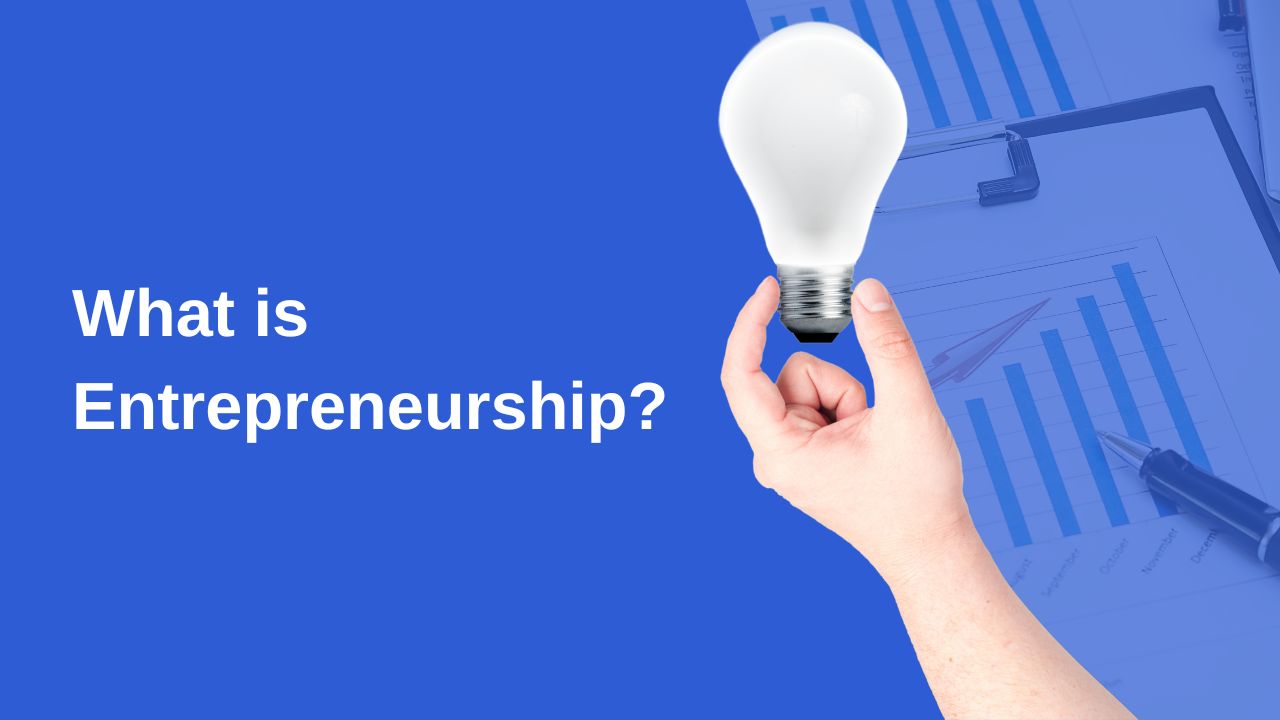What Is Entrepreneurship? The concept of entrepreneurship has been around for centuries. The term itself was first coined in the 18th century by French economist Jean-Baptiste Say. He defined it as “the art of making one’s living by one’s own labor.”
Since then, entrepreneurship has been conceptualized in a variety of ways. For some, it is simply starting your own business and opening up the doors of self-employment. For some involved in entrepreneurial leadership, it’s mentoring aspiring entrepreneurs, raising capital for new business ventures, setting up small businesses or starting some new business venture. Others see it as a mindset or approach to a life characterized by risk-taking and innovation. To read more about the freedoms that Entrepreneurship offers read our blog 9 Freedoms of Entrepreneurship.
At its core, entrepreneurship starts by being empathetic to a customer’s desired outcomes and then taking initiative to deliver products to enhance customers’ lives. It is about creating a solution to customer problems and then being willing to do whatever it takes to turn that solution into an actual product. Entrepreneurs are always learning and constantly seeking new opportunities to solve difficult problems and create a successful business.
There is not a one-size-fits-all definition of entrepreneurship, it means different things to different people. Our unique definition of entrepreneurship considers the customer’s perspective as the primary driver of entrepreneurial activities.
Definition Of Entrepreneurship

Entrepreneurship is the process of providing a product that overcomes a problem stack that impedes a customer’s ability to reach their desired outcomes. The product must deliver improved outcomes for both the customer and the entrepreneur’s organization. It must be technically feasible, financially viable, desirable to the paying customer, and compatible with the strategic ambition of the entrepreneurial organization.
Creating Value Requires Technical Feasibility, Customer Desirability, And Financial Viability.
In order to create value for the entrepreneurial organization, the new product must be technically feasible, desirable to a paying customer, and it must be financially viable.
Technical feasibility means that the product can be built using existing technology available to the venture. Desirability means that the product meets the needs of the customer, and they are willing to pay for the product. Financial viability means that the product can be sold at a price that is high enough to cover the costs of production and generate a profit.
Entrepreneurship Starts By Living A Life Of Service
Many people think of entrepreneurship as simply starting a new business. But it’s much more than that. To be an entrepreneur, you must start with a mindset of service. You have to be enthusiastic about solving customer problems and then be willing to do whatever it takes to turn that solution into an actual product.
This process starts by empathizing with the customer and understanding their desired outcomes. Once you know what the customer wants, you can take initiative to deliver a product that meets those needs. It’s not enough to simply have a great idea – you also have to be willing to work hard to make it a reality.
The Entrepreneurship Process – 5 Core Concepts
Five core concepts are at the heart of the entrepreneurship process. These core concepts are focused on a customer’s perspective and can be used to identify commercialization opportunities.
People Seek Improved Outcomes To Live Enhanced Lives.

All people want to improve their current situation. They are looking for products that are going to make their lives better. To be successful, entrepreneurs need to provide a product that meets this customer’s need for faster, cheaper, and more effective products.
In the past, people have improved their lives by finding new ways to do things. The printing press and the Internet are two examples of products that have changed the world and improved the lives of billions of people. Today, people are looking for improved outcomes in all areas of their lives, including their health, relationships, and finances.
Backcasting is a method for identifying strategies to build your abundant life. This method is designed to get you get to understand your strengths and areas of improvement to cater to your future, allowing for sustainable development and to achieve a desirable future. Check out our blog Use Backcasting to Build an Abundant Life to learn how to use this tool to help design Abundant Life.
A Problem Stack Creates Obstacles Preventing A Customer From Achieving Their Desired Outcome
In order to improve their current situation, customers must overcome problem stacks that are preventing them from achieving their desired outcomes. The problem stack is made up of a series of problems that the customer must solve in order to achieve their goal.
For example, let’s say a customer wants to buy a new car. In order to do this, they must first overcome a series of problems, such as:
- Finding the desired car at a favorable price
- Securing financing
- Getting insurance
- Arranging for the delivery of the car
Each of these problems must be solved before the customer can achieve their goal of buying a new car. In this example, there are four problems in the problem stack.
An entrepreneur’s job is to identify the customer’s problem stack and then create a product that helps the customer overcome these problems. By solving the customer’s problems, the entrepreneur can improve the customer’s current situation and help them achieve their desired outcome.
Value Creation Gaps Are Created By Unsolved Problem Stacks
In order to create value, entrepreneurs must identify and solve problems that are preventing customers from achieving their desired outcomes. The existence of problem stacks causes value creation gaps. A value creation gap is a difference between the current state of the customer’s life and the desired future outcome of the customer.

For example, let’s say a customer wants to buy a used car, but the current state of the customer’s life is that they can’t find the car model they desire at a reasonable price at a local dealer. If the desired outcome of the customer is to buy the car at less than $25,000 but the lowest local dealer price is $30,000, the value creation gap is the difference of $5,000.
In order to close a value creation gap, the entrepreneur must create a product that helps the customer solve their problem stack. In this case, the entrepreneur might create an online marketplace where customers can buy and sell used cars. This marketplace could either be big or small business entrepreneurship which would allow the customer to find the car they want at a price that is lower than the local dealer’s price, thus closing the value creation gap.
Innovative Solutions To Problem Stacks Provide Commercial Opportunities

By providing innovative solutions that help customers overcome their problem stacks, entrepreneurs can create commercial opportunities. These opportunities can be used to generate revenue and create value for the innovator and their stakeholders. Check out our blog 9 Freedoms of Entrepreneurship to find more unique capabilities of Entrepreneurs.
It is important to select a customer problem stack, valuable enough to be worth solving and one that customers find compelling. Many entrepreneurs start with the desired outcome they personally want to improve and then evaluate the market opportunity by conducting empathy interviews with potential customers.
When designing innovative solutions, it is important to focus on what customers want. Innovators need to engage in intensive customer discovery that is disciplined, immersive, and based on rapid learning. Innovators make sense of what they learn from these activities by developing a customer value map. This value map describes the jobs a customer wants to do, the desired outcomes they seek, and the problem stacks they face. Idea generation techniques help innovators to develop potential solutions to customer problems, i.e., the use of divergent thinking skills to generate many potential solutions.
After generating a list of potential solutions, it is important to use convergent thinking skills to select the best solution. Evaluation criteria can be used to make this selection. These evaluation criteria should consider the following factors:
- The ability of the solution to close the value creation gap
- The feasibility of implementing the solution
- The commercial viability of the solution
After selecting the best solution, it is important to validate the solution with potential customers. This validation is most effective when done in face-to-face customer empathy interviews conducted by the entrepreneur.
Strategic Ambition Informs The Boundaries Of A Search

A guiding strategic ambition assists entrepreneurial exploration by connecting an entrepreneur’s discovery process directly to the organization’s aspirations. A strong strategic vision is emotionally appealing, and it should activate the organization’s enthusiasm for innovation. Strategic ambition should provide a set of principles for making choices about what markets the company serves, its business models, and its product offerings. By defining hunting zones (the markets the entrepreneur wants to serve) the strategic ambition gives guidance to the types of opportunities the organization will target. Strategic ambition should be linked to financial performance goals to ensure that the venture will be financially viable.
A strategic ambition is used to keep the organization on a path to meet its commercialization efforts within a well-defined set of boundaries.
Where To Start Your Entrepreneurial Search

In order to be successful, entrepreneurs must start with the customer and work backward. This means that they must first identify the customer’s problem stack and then develop innovative solutions that help the customer overcome these obstacles. Once the entrepreneur has identified a customer problem stack, they can use this information to generate ideas for potential solutions. These ideas can then be evaluated, and the most promising ones can be developed into prototypes. These prototypes can be evaluated with customers to get feedback and further refine the product. Once the product is ready for launch, the entrepreneur can then start working on commercialization efforts to generate revenue and create value for their stakeholders.

When starting with the customer, it is important for an aspiring entrepreneur to keep in mind that customer discovery is an ongoing process. This means that even after the product has been launched, the entrepreneur should continue to engage in customer discovery activities to ensure that the product is meeting the needs of the customer and to generate innovative ideas for product improvements.
Key Takeaway
Creating customer and organizational value is the key to entrepreneurship. Entrepreneurs develop commercial opportunities by delivering solutions to problem stacks that are preventing customers from achieving their desired outcomes.
A successful entrepreneur always focuses on the economic development or economic growth that comes with taking the financial risk of setting up new businesses.







